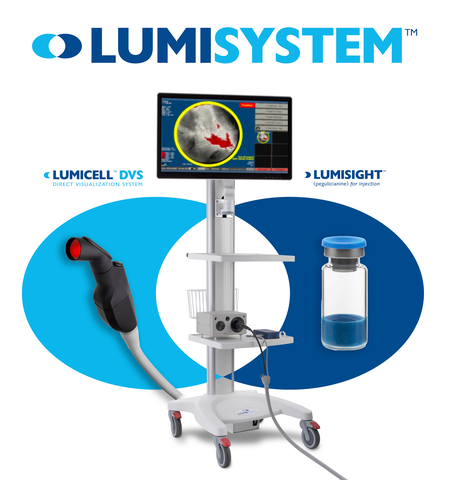NEWTON, Mass.– Lumicell, Inc., a privately held company focused on developing innovative fluorescence-guided imaging technologies for cancerous tissue detection during surgery, today announced the U.S. Food & Drug Administration (FDA) approved the company’s New Drug Application (NDA) for its LUMISIGHT™ (pegulicianine) optical imaging agent and its Premarket Approval (PMA) application for Lumicell™ Direct Visualization System (DVS), together referred to as LumiSystem™.
With 84% diagnostic accuracy, LumiSystem enables surgeons to scan the breast cavity post-lumpectomy, in real-time, to detect and resect residual cancer that may have otherwise been missed, potentially sparing some patients from second surgeries.1-2 The LumiSystem combination is indicated for fluorescence imaging in adults with breast cancer as an adjunct for the intraoperative detection of cancerous tissue within the resection cavity following removal of the primary specimen during lumpectomy surgery.
“We are immensely proud of the dual approval of LUMISIGHT and Lumicell DVS – we believe this is the first drug-device combination product approved in over a decade to have followed both of the FDA’s most stringent NDA and PMA review processes,”3 said Howard Hechler, President and Chief Operating Officer, Lumicell. “With the FDA’s approval, LumiSystem is now the first and only imaging combination product capable of detecting cancerous tissue where it matters most, inside the breast cavity.”
“Breast cancer is all too common, and sadly, 1 in 8 women will develop it during their lifetime,”4 said Kelly Hunt, MD, Chair of the Department of Breast Surgical Oncology at MD Anderson Cancer Center and President of the Society of Surgical Oncology. “Our most common surgical procedure to treat these women is lumpectomy. Unfortunately, the intraoperative tools we have are limited and do not identify the extent of tumor accurately enough, making it challenging to achieve a complete tumor resection, leading to as many as 36% of patients needing a second surgery.”5
“Up to 65% of the time, we do not find residual cancer in the second surgery and are left wondering if we performed an unnecessary surgery due to a false positive margin assessment or if the cancer was missed again in the second surgery,”6 said Irene Wapnir, MD, Breast Surgical Oncologist and Professor of Surgery, Stanford University School of Medicine.
“During lumpectomy surgery, surgeons still struggle to identify and remove all of the tumor during the first operation,”7 said Barbara Smith, MD, PhD, Director of the Breast Program at Massachusetts General Hospital and Professor of Surgery at Harvard Medical School. “With LumiSystem, we will now have a technology that is clinically proven to achieve a more complete cancer resection during lumpectomy that could help some patients avoid a second surgery.”2
The safety of the system was established using data from more than 700 breast cancer patients across five clinical studies at top academic and regional community cancer centers across the U.S. The most common side effects with LUMISIGHT are hypersensitivity and an abnormal color in urine. LUMISIGHT may cause serious hypersensitivity reactions, including anaphylaxis. Results of the Investigation of Novel Surgical Imaging for Tumor Excision (INSITE) pivotal trial, used to support the efficacy of the system, were published in NEJM Evidence.
“We want to thank our clinical investigators and the hundreds of women who participated in our breast program for LUMISIGHT and Lumicell DVS,” said Jorge Ferrer, Chief Scientific Officer, Lumicell. “Due to your important contributions, LUMISIGHT and Lumicell DVS are now approved and will be available in the United States shortly.”
- Diagnostic accuracy is based on true positive and true negative images detected in the LumiSystem pivotal trial
- Smith, et al., NEJM Evidence 2023; 2(7)
- Data on File – Lumicell
- American Cancer Society. Key Statistics for Breast Cancer. Accessed November 1, 2023
- Dupont, et al., Ann Surg 2021; 273(5): 876-881
- Bundred, et al., BMJ 2022; 378:e070346
- Tang, et.al., Am J Surg 2015


